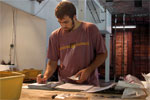By Dan Trepal
As the fifth week of field school comes to a close, I and my fellow students can step back and look with satisfaction at the progress we have made while at the same time using our newly-developed skills to continue to explore the fascinating archeology at the West Point Foundry site. I'm very excited to be participating in this project - having completed undergraduate work in anthropology, I am currently preparing for a graduate education in archaeology and have found the Michigan Tech field school here at the Foundry site to be a great place to gain further field experience in archeology. I can develop skills I have gained in the past while learning new techniques at the same time, and have fun doing it!
The excavators at the blast furnace experienced some interesting discoveries this week. In one of the units, to the west of the blast furnace proper, excavations were finished this week. Before being closed down it yielded an iron artifact resembling a barrel hoop in context with a stain in the soil that may represent the barrel itself. More importantly, this unit contained some deposits of coal, charcoal and slag - possible by-products of the blast furnace operation which may help us better understand how the furnace was being operated and what kinds of materials were being processed in it over 160 years ago.
Another pair of units at the blast furnace made a great deal of progress this week as well. These two are located right in front of the casting arch of the furnace - the part that molten metal streamed out of when the furnace was being tapped during its working period. This area was a focal point then and is still very much a point of interest to the industrial archaeologist. Students uncovered the stone lintel at the base of the casting arch, further defining the structure of the furnace and making it easier to visualize its construction. They also continued to record the various layers of rubble they encountered and collected samples of furnace-related materials like charcoal and slag.
At the East Bank House we finished the remaining shovel test pits, which were located inside the foundations of the house. These test pits revealed evidence of a structure fire: at some point in the past, the house appears to have burned. After this interesting development a new phase of excavation was begun. Up to this point we had been digging a series of shovel test pits to understand what the soils looked like throughout the site and what kind of artifacts or features were present in specific areas.
Armed with this data we opened excavation units in areas of particular interest: First, a shallow test trench near the East side of the house to investigate some bricks, apparently in course (fitted together), discovered just under the topsoil. Second, a 2 by 2 meter square unit to expand on the discovery (by one of the shovel test pits) of a cut stone which may be part of the foundation of an as-of-yet undiscovered structure. The third and final excavation unit was opened inside of the privies - this is where I will be working. These outhouses often yield a large amount of artifacts which will help flesh out the history of the East Bank House, and its occupants over the years.

Dan Trepal, the author, catalogs in the field lab on Main Street



